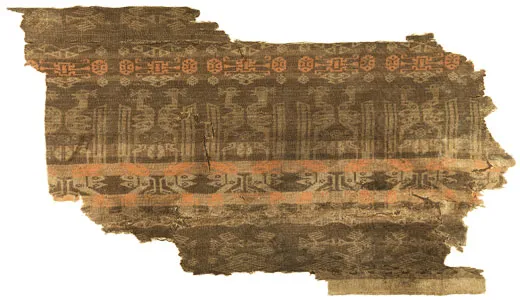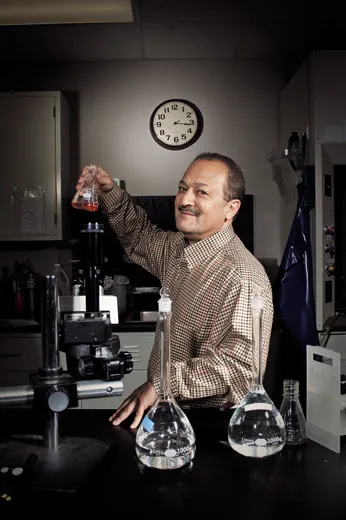How Old is That Silk Artifact?
A chemist from the Textile Museum is perfecting a new technique for understanding the past
/https://tf-cmsv2-smithsonianmag-media.s3.amazonaws.com/filer/Stiches-in-Time-Chemist-Mehdi-Moini-631.jpg)
People have been weaving silk into fabric for at least 5,000 years. The delicate material, made from the threads silkworms excrete to create their cocoons, has been used for everything from the robes of Byzantine emperors to the parachutes of World War II paratroopers. In ancient China, the birthplace of silk, it became luxury paper, a medium for paintings and even a form of currency; for centuries, laws forbade anyone except the emperor and other dignitaries from wearing it as clothing. Silk has been found in the tombs of Egyptian mummies, and in ancient Rome it was blamed for making young women promiscuous.
To historians, silk artifacts reflect the trade and social customs of past cultures. Researchers have long sought a surefire method that measures the age of silk for which there is no continuous historical record and uses just a tiny sample of the material. Now Mehdi Moini, a chemist at Smithsonian’s Museum Conservation Institute, has developed a technique to date silk based on its chemical composition. His technique serves as a kind of clock, and he is testing and calibrating it with silk of known vintage in the Institution’s collections. “Making a clock is easy,” he says. “Calibrating the clock is difficult.”
Silk proteins are made of amino acids, small molecules with a three-dimensional structure. Each amino acid has two possible variants, exact mirror images of each other: left-handed, known as “L” amino acids, and right-handed, referred to as “D.” The amino acids produced by most living things—like silkworms—are left-handed. The key to the dating process, Moini says, is that as silk proteins age, some of the amino acids rearrange themselves into the D variant. He can tell how old a silk thread is by looking at the ratio of D to L amino acids. At year zero, all will have the L structure; given enough time, there will eventually be equal parts of both. Researchers have been using this approach on various proteins for decades, but Moini is the first to apply it to very small samples of silk, says Darrell Kaufman, a geologist at Northern Arizona University.
Moini and his colleagues borrowed a Chinese textile more than 2,000 years old from the Metropolitan Museum of Art and a flag from the Smithsonian that was used in 1846 in the Mexican War. Sumru Krody, senior curator at the Textile Museum in Washington, D.C., let him take samples from an ancient Egyptian tiraz, a ceremonial turban band with an inscription dating it precisely to A.D. 993. “It’s very hard to find textiles with an accurate date on them,” she says. “But sometimes you get lucky.”
Moini’s method uses a minuscule amount of material, something that appeals to curators of priceless fabrics. “If you go to a museum and say, ‘I want five milligrams of this precious silk,’ silk is very light, so five milligrams is a lot of compound,” Moini says. Previous techniques, such as carbon dating, consumed several milligrams of silk for each test; by contrast, he needs just one-hundredth that amount. “If there’s just one tiny speck of fabric,” he says, “it’s enough for us to do the analysis.”
To determine the ratio of D to L amino acids in each piece of silk, Moini and his team dissolve the fabric in hydrochloric acid, put the liquid in a thin glass tube and apply an electric field. Because amino acids have a slight electrical charge, they are pulled through the tube. The tube also contains a substance that chemically attracts the D amino acids. “Think of it like this: You have a bunch of hands, left and right hands, and then we fill the [tube] with only right gloves,” Moini says. “Only the right hand goes into the right glove and gets caught, and the left hand cannot fit into the right glove, so it goes through faster.”
After analyzing a variety of silk samples, Moini and his team determined that 50 percent of the amino acids change from L to D forms after 2,500 years.
The technique is more efficient and more precise than previous methods. It will soon be put to use to date artifacts of unknown age. “After this technique is fully developed, it’s then the fun part will start,” says Krody. She may use the dating method on items such as the Buyid silks, a group of artifacts that may have originated in Iran sometime between the 8th and 12th centuries.
/https://tf-cmsv2-smithsonianmag-media.s3.amazonaws.com/accounts/headshot/joseph-stromberg-240.jpg)


/https://tf-cmsv2-smithsonianmag-media.s3.amazonaws.com/accounts/headshot/joseph-stromberg-240.jpg)